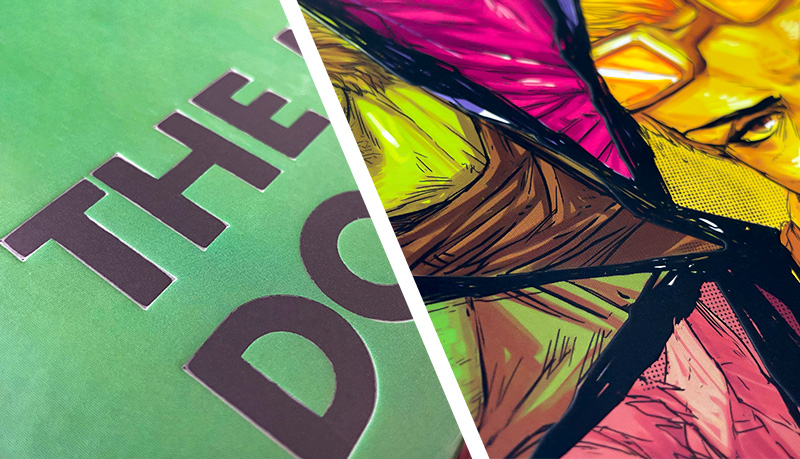We work frequently with entrepreneurs, heads of business, and thought leaders to print high-level copies of their books. Here, we share out best advice for designing a business book cover that converts.

As an entrepreneur or business leader, crafting a business book serves as a strategic maneuver to establish authority within your industry, vertical, or niche. Beyond merely compiling insights, it's about sharing vision and learned lessons, fostering personal growth, and enhancing your reputation and the reputation of your enterprise.
With all the emphasis on content creation, the significance of the book cover design often gets relegated to second place or even be overlooked. But business book cover design is far from being a secondary consideration. The cover does more than protect the interior pages; it serves as the first point of contact with potential readers. It stands as the initial invitation, beckoning potential clients, colleagues, subscribers, and customers to explore the benefits of your expertise.
Why business book cover design matters
So, then, the book cover serves as the initial point of contact for potential readers, embodying and communicating your credibility as a business person and an author and acting as a gateway to further professional opportunities. Its design can significantly impact book sales and influence its power to attract engagement from potential clients.
In short, a well-designed business book cover encourages readers to explore its contents further, while a subpar one risks losing their interest to competing titles. There are four core principles of design and use which make a thoughtfully designed business book cover.
- Targeted appeal: The imagery and design elements should resonate specifically with the intended audience, avoiding a one-size-fits-all approach in favor of precise targeting.
- Brand cohesion: The author's identity as an entrepreneur should seamlessly align with their persona as an author, fostering a unified brand image.
- Content preview: The cover provides a glimpse into the book's tone and subject matter, setting appropriate expectations for readers, whether scholarly or action-oriented.
- Promotional versatility: Beyond promoting the book itself, the cover can be leveraged across various marketing channels, amplifying visibility and engagement on websites, social media, and professional profiles.
A professionally designed book cover transcends simple aesthetics; even if it “looks good”, that's not enough. It must serve as a potent marketing tool with significant implications for your authorship and your entrepreneurial endeavors. So, now let's dive into the details and show you how to get a business book cover design that gets results.
Working with a professional cover designer
We always recommend working on the final design — if not from the outset, — with a qualified, experienced, professional book designer with a positive portfolio and a good track record. Designing a business book cover needs a skilled blend of artistic flair, technical know-how, and strategic marketing insight. Unless you already have well-developed and proficient graphic design skills, collaborating with a seasoned book cover designer specializing in business publications is probably the way to go.
Professional book cover designers have more than the needed expertise to craft visually appealing covers. They also have a keen understanding of market preferences in business book designs, keep their eyes on the latest trends, and should have years of experience under their belt. A good designer attracts a significant fee, it's true: but you're not just paying for a picture and a few words; you're paying for years, possibly decades, of unique experience and knowledge-building.
That said, trusting your manuscript to a designer, however good their reputation, without preparatory steps is unwise. And you'll surely want to input your own creative ideas and aims into the process. So, before engaging a designer, consider taking these pre-emptive measures that can help to streamline the process and optimize both time and expenditure.

- Make a selection of cover designs you like. Browse around the bestseller lists on platforms like Amazon to identify covers that capture your attention and are obviously working in the marketplace. Save screenshots of these designs and consider annotating them with your impressions and reasons why you think they have such strong appeal. When you contact a potential designer, show them this collection, which will give them valuable insights into your preferences and potentially expedite the design process, saving time and money.
- Clarify your cover text content. Before embarking on a collaboration with a business book cover designer, think through the essential elements such as title, any subtitle, author name, and back cover “blurb”. Organize supplementary materials, including author bios, endorsements, and reviews, in a coherent and succinct way for easy access by the designer, minimizing unnecessary to-ing and fro-ing.
- Be clear about what you don't want on your business book cover design. Give serious thought to what specific elements you unequivocally wish to avoid on your cover, be it certain color schemes, typefaces, or imagery. Getting this straight at the outset facilitates efficient communication with the designer, reducing the need for iterative revisions and optimizing resource use.
- Be clear about branding. The book cover — while it needn't stick too rigidly to your brand guidelines — should still have “brand recognition” built into it. This could be as complex as sending full brand guidelines, with selected typefaces, color palettes, logos, image preferences, and brand keywords. Or it could be as simple as including an author photo on the back and a logo.
Your book serves as an extension of your brand identity as well as a means of communication and a marketing tool; for that reason, harmonizing the cover design with your brand ethos and planning these fundamentals in advance, can really help guide your designer's best efforts and help you get the results you want from your book.
Taking the D.I.Y. route to business book cover design
When it comes to designing your business book cover, teaming up with a professional designer is a smart move. It's definitely what we will always recommend. But if you're determined to rise to the challenge and head down the D.I.Y. route, understanding what makes a good cover can help you work better and smarter to achieve your results. Here are our top tips.
Choose the right software
Getting the best software is half the struggle. We recommend Adobe Illustrator for book cover design (and you can also download one of our custom-designed free book cover templates to get you started in the right direction. Other good software options are Affinity Publisher, Adobe Indesign, and at a push, Canva. Either way, get your learning boots on and prepare to climb the curve.
Keep it simple
Successful business book covers often keep things simple, focusing on the title, subtitle, author's name, and maybe a single image. This simplicity helps the important parts, especially the title, stand out. But don't be fooled — creating a simple yet effective cover can be quite challenging. Again, look at the bestsellers in your genre or niche and analyze what's working.
Keep your title on top
We don't necessarily mean this literally, but unless you are a household name already, our book's title should be the star of the show on the cover. It needs to be easy to read from a distance or in small sizes, like on an online bookstore page. Typically, business book titles are short and catchy, while the subtitle explains what the book is about.

Contrast is eye-catching
The contrast between the background and the text is vital for readability. Covers with high contrast — this is not the same as “clashing” — are more likely to catch a reader's eye, so make sure your text stands out against the background.
A picture speaks a thousand words
The image or images on your cover should match the content of your book. For example, if your book is about increasing sales, a graph showing rising revenue would be fitting. Avoid unrelated images, use an original image if you can, or an appropriately licensed and credited image otherwise.
Writing a business book involves both creating valuable content and designing an inviting cover. Both are essential for establishing your authority and attracting readers. Remember, your book's cover is a promise to your readers — a promise of valuable insights waiting inside.
Talk to us!
Generating a successful business book cover design requires attention to detail and adherence to industry standards whether you engage the services of a third-party designer or choose to do it yourself. By following the guidelines outlined in this tutorial and incorporating the tips and insights provided, you'll be well-equipped to create a winning book cover. Still need more help? No problem! Just get in touch. We're always here to support our valued customers.









